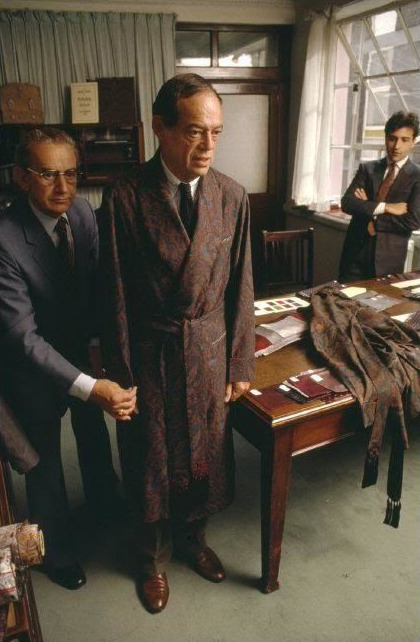
I found this photo on a friend’s Twitter feed last year. It’s from 1985 and shows the old Holliday & Brown shop in London. For those unfamiliar, Holliday & Brown was a legendary English tie-maker back in the day, although they also made shirts and dressing gowns. Here, one of their customers is being fitted for an ancient madder gown, with a sales associate showing what the sleeves will look like once they’re shortened.
I’ve been wanting an ancient madder gown ever since. Soft and chalky, I imagine wearing one would feel like you’re wrapped in a thin suede. Unfortunately, it seems they’re are no longer available today – at least in the kind of dusty, muted prints you see above.
Some years ago, scientists found that two of the three dyes used to make madder caused cancer in rats. Which meant, when printers dyed their silks and dumped the solutions out to disposal plants, they risked getting carcinogens into water supplies. They never found a way to filter out those chemicals, so the dyes were banned and replaced with synthetics. Today, only the third dye (indigo) remains in its original form.

I’ve always known that to be the case, but I never realized what a big difference it makes for modern madder production. Today’s madders are undeniably beautiful – they have the same chalky feel, but just with very different colors. Indigo gives modern madder the same bright blues, but the reds and yellows just aren’t as dusty or muted. The difference isn’t as noticeable in a tie, but it really comes out in a gown.
Compare, for example, the two photos above – the first being the old Holliday & Brown ancient madder and the second some modern madders from Keyte Silks (later used for Shibumi ties). New madders still look great with tweed sport coats and flannel suits, but they’re also a lot more vivid and bright compared to the old designs.
Andrew Rowley, the shop manager at London’s Budd Shirtmakers, tells me Adamley is working on some new discharge-dye versions of madder. The method may get some dustier designs, although it probably won’t be exactly the same as the old stuff. David Hober, co-founder of bespoke tie-maker Sam Hober, also says he’s working on an environmentally safe way of producing old madder prints. Here’s to hoping they’re successful cause I’d love to wear a dusty, muted silk dressing gown on a fall morning.
